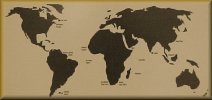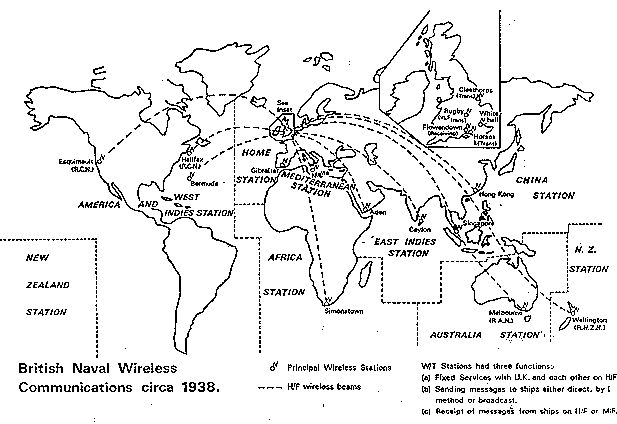Hello,
I have just found your interesting website and was wondering whether anyone had information on the above. My grandfather, Allen Abraham Cornell was a Submariner (Telegraphist) in the Royal Navy from 1924-1933. He served on L22, L25 and L56. I have many photos of his time in the navy and also on the wireless station in Matara, Sri Lanka where he was stationed from the middle of 1930 to the end of 1932. Unfortunately, I can find no reference to this wireless station or of anyone who served there. I have tried many avenues, but no information is available. I believe he travelled to Matara on HMS Effingham on 1st July, 1930. If anyone has any information on this I would appreciate it. Sadly, my grandfather died a few months after coming out of the Navy, in 1934 at the age of 31 years.
Thank you for your time.
Sue Dewey.
Susan,
Thank you for your interesting message.
Here are three snippets, the first two from the Museum at Mount Pearl in Canada where the very first wireless telegraphy station was built in 1914.
From the attached map of these 13 stations one was in Ceylon, and would I believe be where your Grandfather served as a telegraphist.

The third para I found on a site listing how soccer was introduced into Ceylon, and gives credit to the Sailors stationed at Matara Wireless station for bringing that game to the Southern Province of Ceylon. You are quite right the Royal Navy did have a wireless station at Matara in the then named Ceylon.
I will continue to try and establish more from Marconi about these stations, but as you are well aware its not an easy subject to track down.
Could you please as convenient send me a sample of your Grandfather's photographs, we would love to put them up on AHOY.
Best wishes, and should I turn up anything more, I will of course again be in touch.
The wireless telegraphy station at Mount Pearl was first proposed by the British Admiralty on June 27, 1914 and became fully operational on September 16, 1915. This facility was one of thirteen wireless stations erected at the same time by the Marconi Company for the British Navy to improve its war time intelligence gathering and weather reporting capabilities.
The installation engineers for the station in Ceylon were Radner ( or Hadner) and Lunnon and probably completed in June 1915. The Ceylon station was one of 11 identical stations the others were at : Bathurst ( Gambia), Durban, Demerara, Seychelles, Singapore, St John's, Aden, Hong Kong, Mauritius, Port Nolioth SA (sp ?). A further 150kw station was built in 1916 at the Falkland islands (some remains on site as also at Ascension Isl
In the Southern Province, the sport had a fair impact on the masses, with the planting and administrative community leading in the promotion of the game in a big way. R. Brough, a British planter in Deniyaya, contributed much to the sport in the South between 1910 to 1920. The British servicemen from the Navy wireless station in Matara, also helped to popularize the sport, particularly in the southern schools. The first football club formed in the south was the Galle Association Football Club in 1910, with obviously a predominently British membership. R. R. Brough was its first President and the club team was captained by A. C. Blair.
Mac. Gregory.
Hello from Australia,
I would be grateful if you have any details when the wireless telegraphy station at Matara in Ceylon was built and opened, and any history of that station would be appreciated.
With thanks and best wishes.
Mackenzie Gregory.
Lieutenant Commander RAN. Retired.
Hello Mr. MacKenzie Gregory,
thank you for your interesting enquiry. As far as I can tell all 13 stations were built by the Marconi Wireless and telegraphy company to an Admiralty specification. They were built between November 1914 and the summer of 1915 when most became operational. The site here in Newfoundland (a "Navy H" station call BZM with a transmit power of 30kw) became operational on September 16th 1915. The station was put on care and maintenance in 1922 along with the Jamaica, Bermuda and Demerara w/t stations ( letter 27th April 1922 from Vice-Admiral CIC North America and West Indies). This is the only record I have of the existence of the Jamaica and Bermuda stations as they do not appear on the construction list.
The installation engineers for the station in Ceylon were Radner ( or Hadner) and Lunnon and probably completed in June 1915. The Ceylon station was one of 11 identical stations the others were at : Bathurst ( Gambia), Durban, Demerara, Seychelles, Singapore, St John's, Aden, Hong Kong, Mauritius, Port Nolioth SA (sp ?). A further 150kw station was built in 1916 at the Falkland islands (some remains on site as also at Ascension Isl.)
We have collected a number of excellent images of the station here and also have the complete specifications and plans for the station from the Marconi Co. in Chelmsford England. We do not have much at all on the other stations. I would be interested to know what information you have.
Alasdair Black
Museum Coordinator
Admiralty House Museum
I joined the Royal Australian Naval college as a 13 year Cadet Midshipman back in 1936, spent WW2 totally at sea or overseas, including 3 weeks in Ceylon in 1941, was sunk at the Battle of Savo Island in HMAS Canberra, being her Officer of the Watch when the battle started, saw the war out in her replacement HMAS Shropshire, being in Tokyo Bay for the surrender of the Japanses in September 1945. I stayed in the RAN
until 1954, resigning for personal reasons.
The history of wireless telegraphy is an interesting one, and I should write up about the subject for my Mac's Web Log at URL: ahoy.tk-jk.net where we have a great deal of Naval History, and the site has had over 55,000 visitors.
Nice to hear from you.
Best wishes and regards from Australia.
Mackenzie.
Sue,
Here is a map showing British Naval Communications world wide in 1938, and in Ceylon is a Principal Wireless Station.
This no doubt was at Matara in Southern Ceylon.
Best regards,
Mac.

Mac,
Thank you very much for taking the time to answer my question on the Matara Royal Navy wireless station in Ceylon. I have my grandfather's naval records which don't give a lot of information, but luckily, having the photos has helped me build up a picture of his naval life and time in Matara. I have a couple of pictures of the Weligama Rest House, which I have heard mentioned before. My problem in getting information is possibly because he served between wars, so there is not so much documented history.
I will send you some photos of my grandfather's time in the Navy during the 1920s and 30s for your website as requested as soon as I can process them onto e mail.
Again, your help has been much appreciated.
sincerely,
Sue.
back to letters index


